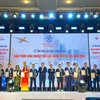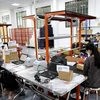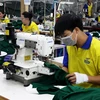Agro and aquatic exports have experienced a slowdown in recent times, suffering from a disparate array of difficulties such as inadequate zoning, lack of production materials, insufficient investment and low added value, radio The Voice of Vietnam (VOV) reported on June 9.
The agro-aquatic export turnover is forecast to reach 8.9 billion USD this year, up over 12 percent compared to last year’s same period, according to the Ministry of Industry and Trade. However, it is significantly important to note that the group’s exports underwent a serious decline of 17 percent during the month of May compared to April.
Other factors hindering the group’s exports included inadequate financial capacity of businesses, markets’ low demands for consumption and stiff competition from other nations.
At present, the world’s rice market is facing huge challenges as the excessive supply is creating a glut in the global marketplace and fierce competition puts severe downward pressure on the sales.
To add fuel to the fire, there is greater downward pressure on Vietnamese rice in the world market as a result of Thailand's flooding the global market with its rice reserves and new supplies from Myanmar and Cambodia as they beef up production.
Meanwhile, the imposition of a tax rate of 1 percent on rubber exports has also caused increased difficulties for the sector. Vietnam has technically established standards on quality for rubber exports. However, there are no compulsory regulations requiring adherence to the established standards.
The hike of input costs such as electricity, water and transport have been observed in the domestic market which are further compounding the difficulties faced by the sector.
An Phu Seafood Joint Stock Company Deputy General Director Nguyen Hong Le said that local businesses should stay active in producing agricultural feed to avoid negative impact from the global market on the seafood products’ costs.
Chinese businesses accounted for 35 percent of the country’s total agricultural feed. Meanwhile, 85 percent of the quality of tra fish depends much on this feed and local businesses should capitalise on this demand. Some businesses which have processing factories can produce high quality agricultural feed. However, farmers who do not have such factories cannot control the quality of input feed.
Le asked the State Bank of Vietnam to provide domestic businesses with loans at low interest rates to help them invest in producing feed for tra fish and ensuring an aquaculture zone to improve the quality of tra fish in the future.
The seafood material for export processing makes up just 70-75 percent of the processing factories’ demand (equivalent to 60-65 percent of these factories’ capacities), affecting the production costs and the supply of products to markets. Moreover, there are shortages of capital for shipbuilding as fishing facilities and costs for the exploitation of these products remain high. Especially, the market demands are low, leading to low export prices.
Nguyen Huu Dung, Vice President of Vietnam Association of Seafood Exporters and Producers, underlined the need to study and learn about market conditions to offer a more competitive export price.
The association proposed some projects to set up a wholesale market to export frozen fish fillets to the European market in the form of auction. If the product is auctioned in the international market, the world market will decide the price, Dung said, adding the adjustment of balancing the supply and demand will provide a basis for the price of Vietnamese seafood products.
At present, agro-aquatic export turnover accounts for 15 percent of the country’s total export turnover. However, there are few programmes to promote farm produce.
Deputy Minister of Industry and Trade Tran Tuan Anh said that businesses should work hand in hand with relevant ministries to implement trade promotion programmes and build trademarks for farm produce in the international market to bring higher efficiency for export items.
He said that despite the state’s support, businesses should be active in building a long-term programmes and developing trademarks in association with market access. In the future, one of the priority contents in boosting trade promotion activities is to set up a cooperative model among the state’s management agencies, associations and businesses.
According to economic experts, it is necessary to identify Vietnam’s comparative advantages and select some strategic commodities to invest in a synchronous manner and set up a complete supply chain including production, processing and consumption. In addition, it is needed to boost post-production and post-harvest processing stages to export high quality farm produce.
Nguyen Do Anh Tuan, from the Centre for Agricultural Policy Director at the Institute of Policy and Strategy for Agriculture and Rural Development, said that there should be immediate support solutions for the agricultural sector and ways to link farmers to the global chain.-VNA
The agro-aquatic export turnover is forecast to reach 8.9 billion USD this year, up over 12 percent compared to last year’s same period, according to the Ministry of Industry and Trade. However, it is significantly important to note that the group’s exports underwent a serious decline of 17 percent during the month of May compared to April.
Other factors hindering the group’s exports included inadequate financial capacity of businesses, markets’ low demands for consumption and stiff competition from other nations.
At present, the world’s rice market is facing huge challenges as the excessive supply is creating a glut in the global marketplace and fierce competition puts severe downward pressure on the sales.
To add fuel to the fire, there is greater downward pressure on Vietnamese rice in the world market as a result of Thailand's flooding the global market with its rice reserves and new supplies from Myanmar and Cambodia as they beef up production.
Meanwhile, the imposition of a tax rate of 1 percent on rubber exports has also caused increased difficulties for the sector. Vietnam has technically established standards on quality for rubber exports. However, there are no compulsory regulations requiring adherence to the established standards.
The hike of input costs such as electricity, water and transport have been observed in the domestic market which are further compounding the difficulties faced by the sector.
An Phu Seafood Joint Stock Company Deputy General Director Nguyen Hong Le said that local businesses should stay active in producing agricultural feed to avoid negative impact from the global market on the seafood products’ costs.
Chinese businesses accounted for 35 percent of the country’s total agricultural feed. Meanwhile, 85 percent of the quality of tra fish depends much on this feed and local businesses should capitalise on this demand. Some businesses which have processing factories can produce high quality agricultural feed. However, farmers who do not have such factories cannot control the quality of input feed.
Le asked the State Bank of Vietnam to provide domestic businesses with loans at low interest rates to help them invest in producing feed for tra fish and ensuring an aquaculture zone to improve the quality of tra fish in the future.
The seafood material for export processing makes up just 70-75 percent of the processing factories’ demand (equivalent to 60-65 percent of these factories’ capacities), affecting the production costs and the supply of products to markets. Moreover, there are shortages of capital for shipbuilding as fishing facilities and costs for the exploitation of these products remain high. Especially, the market demands are low, leading to low export prices.
Nguyen Huu Dung, Vice President of Vietnam Association of Seafood Exporters and Producers, underlined the need to study and learn about market conditions to offer a more competitive export price.
The association proposed some projects to set up a wholesale market to export frozen fish fillets to the European market in the form of auction. If the product is auctioned in the international market, the world market will decide the price, Dung said, adding the adjustment of balancing the supply and demand will provide a basis for the price of Vietnamese seafood products.
At present, agro-aquatic export turnover accounts for 15 percent of the country’s total export turnover. However, there are few programmes to promote farm produce.
Deputy Minister of Industry and Trade Tran Tuan Anh said that businesses should work hand in hand with relevant ministries to implement trade promotion programmes and build trademarks for farm produce in the international market to bring higher efficiency for export items.
He said that despite the state’s support, businesses should be active in building a long-term programmes and developing trademarks in association with market access. In the future, one of the priority contents in boosting trade promotion activities is to set up a cooperative model among the state’s management agencies, associations and businesses.
According to economic experts, it is necessary to identify Vietnam’s comparative advantages and select some strategic commodities to invest in a synchronous manner and set up a complete supply chain including production, processing and consumption. In addition, it is needed to boost post-production and post-harvest processing stages to export high quality farm produce.
Nguyen Do Anh Tuan, from the Centre for Agricultural Policy Director at the Institute of Policy and Strategy for Agriculture and Rural Development, said that there should be immediate support solutions for the agricultural sector and ways to link farmers to the global chain.-VNA



















